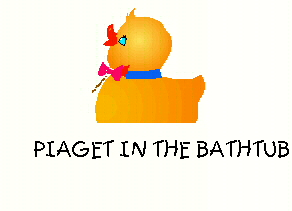INFANT DEVELOPMENT AND BATHS
Below is a brief description of how baths can be a time for learning and infant development. PLEASE do not get the mistaken notion that you need lots of toys and money to provide a good environment for development. At the moment, the favorite object that "Julia the toy-rich baby" likes to play with is a box that some lightbulbs came in. It is light, so she can pick it up and wave it around. It has two parts, so she can pull it apart and put it back together. It is multicolored with a picture and writing on it, so she finds it interesting to look at. She can put it in her mouth. What more could a baby want?
 Julia loves baths. She is almost six months old
now and often has two to four baths each day. In part, this is because
she is just starting to eat solid foods and every feeding requires a bath
because she will have sweet potatoes under her neck, in her hair, on her
eyelashes and covering her little protruding belly. In part, she gets many
baths because she enjoys them and this is sometimes the last resort of
whoever is watching her when she is crying because she is tired, teething
or just plain crabby.
Julia loves baths. She is almost six months old
now and often has two to four baths each day. In part, this is because
she is just starting to eat solid foods and every feeding requires a bath
because she will have sweet potatoes under her neck, in her hair, on her
eyelashes and covering her little protruding belly. In part, she gets many
baths because she enjoys them and this is sometimes the last resort of
whoever is watching her when she is crying because she is tired, teething
or just plain crabby.
There is a developmental benefit to bathing, too, and I think it is no accident that most well-run preschool and early childhood programs include "water play" as a frequent activity. Let's look at Piaget's theory of infant development and Julia in the bathtub.
Piaget says that children learn through their senses and physical exploration of the environment. The bathtub is a great place for a variety of sensations and physical play. First of all, she is immersed in warm water – a unique sensation compared to the rest of the day – she can splash the water with her hands and feet, roll over in it and kick around in it. Sometimes we put bubbles in it and sometimes not, so this gives her variety in stimulation, both in what she is looking at and feels on her skin (because the bubbles make her more slippery). Then there are the toys in the bathtub. You may as well know that Julia, being her father's first and only child, born when he was forty-one years old, has acquired more than her fair share of toys. She has two yellow rubber ducks and twelve, plastic ones. She also has three boats of various colors, a dozen blocks, a set of plastic floating animals, a bath puppet and a long plastic tube filled with balls and gears and other things that move when water runs through it. Most or all of these go into the bathtub. These provide her with a variety of sensory experiences
- Visual: they are all different shapes and colors for her to see
- Tactile: they are different shapes and textures for her to feel square, rounded, plastic, rubber and terrycloth, smooth and ridged,
- Auditory: her rubber duck's squeak, the sound of the water splashing, her puppet "talking" (okay, the puppet doesn't actually talk, really it's us pretending that it's talking!) and her father singing the rubber ducky song (on-key, surprisingly).